#Creatrix Records
Explore tagged Tumblr posts
Text
I gotta say, my favorite podficcer @cailynwrites (AKA the actual voice of Draco and Harry inside my brain, all the way back to Lumos by birdsofshore 🥲) recording my favorite fic author’s works @dodgerkedavra (AKA creatrix of perfect soft dom Draco taking care of overpowered sweet Harry always with a mysterious and heart wrenching twist of some sort 🥹) feels like a personal gift to me, and I am utterly delighted and will listen to them forever on repeat, you cannot stop me!! 🤓
So grateful for their contributions to this fandom!
Go check out their works on good ol’ AO3 and give them all the kudos and warm fuzzy comments!
Dodgerkedavra & Cailynwrites (ETL Echoes)
22 notes
·
View notes
Text
Four Maidens
Article Talk
The Four Maidens are Pan-Remnant female dieties of the four seasons. Modern Archeologists trace their origins to central Anima, where the cult of worship then spread out to the rest of the known world. Below is a record of the oldest mention of the Four Maidens.
"Summer, Fall, Winter, and Spring
Wash, Quake, Burn, and Breeze
West, South, North, and East
Always four, and never three
Maiden Zima creates the freeze
Maiden Vasantha knows the trees
Maiden Shemu burns all things
Maiden Zahuãni brings the breeze
Create anything you need
Know that there are 4 of all things
Destroy obstacles within your path
Make Choices and decide your path
The Four Maidens rest in thee
So you must decide your destiny."
This record was discovered on a stone tablet within a ruined city located in the deserts of Anima. It's contents are connected to themes of the passage of time, the rule of 4, and changing one's fate. Curiously, each of their names are linguistically desperate, which has led to countless theories of a Prehistory Interconnected-Remnant.
Maiden Zima
The Winter Maiden, also known as the Creatrix, is depicted as a pale woman from the north (in modern day retellings, Solitas) with snow white hair and a variable eye color (usually sky blue). Her entire body is covered by clothing except for her head, and her long hair is styled in a bun[source?]. In pop culture, she is commanly compared to world famous singer Weiss Schnee visually.
She carries with her a magical staff that has the power to create anything, including new animals. In most stories, she uses her staff to individually create each snowflake, which is why no two snowflakes are exactly alike. In some versions, she is associated with the genesis of Semblances.
Maiden Vasantha
The maiden of Springtime, A.K.A. the Oracle, is often visualized as the youngest maiden, and having blonde hair and a dark complexion with bright green eyes. Her epithet comes from her ability to answer any question asked of her. She also posesess the magical ability to control plant growth, and is said to be responsible for which plants bloom during Springtime.
In her earliest depictions, she carries with her a small lanturn that she uses to navigate during the night. This lanturn is associated with her Omniscience.
Maiden Shemu
The Summer Maiden, also called the warrior, the destroyer, the lioness, etc, is envisioned as a brown woman with bright red hair, little clothing, and weilding a silver sword. Her sword is said to kill any life that touches the blade, which is why she is always depicted with silver guantlets. In all of her older depictions, Shemu is using her sword to kill Grimm, which are also susceptable to the power of her sword.
Unlike the other maidens, Shemu's association with Summer is secondary to her role as a the mythical First Huntress. The cause of summer is from the light reflected from Shemu's silver sword, which is said to be so bright that it turns night into day.
Maiden Zahuãni
Lady Fall is said to be a normal looking woman, when she is described at all. She is often regarded as the most mysterious maiden by virture of the lack of information surrounding her when compared to the other maidens. However, she is known to have the ability to speak to the dead, and is sometimes regarded as a Psychopomp.
Within the Southeastern region of Eastern Sanus/Vale's surrounding territory, there exists a maiden tradition where Zahuãni is centered. In this rural tradition, Zahuãni is casted as a princess of a hidden civilization within the jungle and she noticably wears a crown that tells her right from wrong. Her eyes, and the eyes of every person from her kingdom, are said to be the same color as Maiden Shemu's silver sword. In this version, Zahuãni is the leader of the maidens and, after she dies, her spirit chooses a new maiden worthy of her power to carry on the mantle, repeating the cycle.
#the four maidens are sp interesting when they have actual lore propping them up#the stuff with the old man is just one story in my au that just so happens to be true#rwde#rwby fix it fic#rwby rewrite#rwby au#rwby 14#and I hope you noticed another connection between the SEW and southeast Vale cuz we are going to keep bringing that up until we get to them#in my au#and yes this is written like a wiki article
11 notes
·
View notes
Text
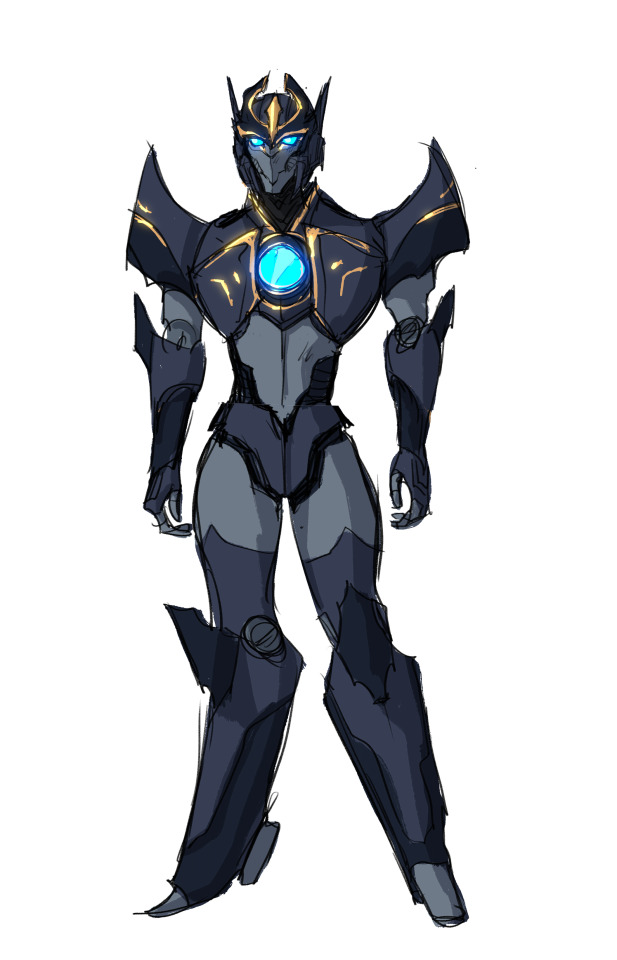
APHELION | OC | MULTICONTINUITY Aphelion is the reigning Praetor of Caelus, a distant colony lost to Cybertron before history had begun to be recorded, and was raised since his birth to carry The Creatrix, a sort of conduit or key to the life-giving core of the planet, and to provide guidance, counsel, and leadership to his people. While Caelus is a politically divided world, it is a thriving one, and now that Aphelion has re-established contact with Cybertron, he does his best to balance the needs of his people and provide aid to the citizens of a war-torn Cybertron. Studious, dutiful, stiff. ABOUT CAELUS
8 notes
·
View notes
Text
Goddess of the Week: Mut
"Lady of Heaven, Mistress of All the Gods"
Happy Fall Equinox! In honor of The Goddess, I’m starting a weekly thread studying a particular Goddess each Moonday! 🪷🪷
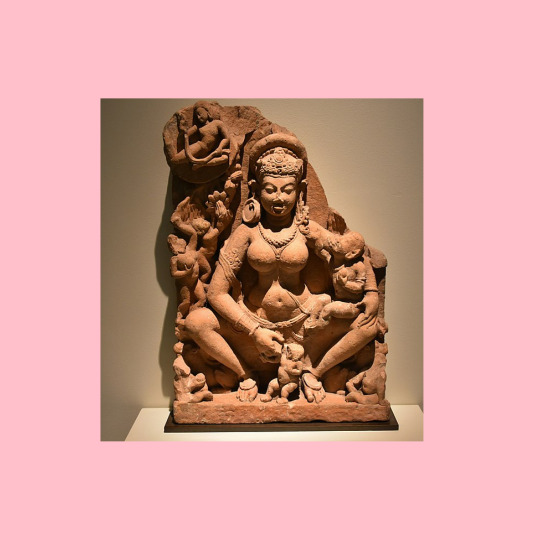
Week 1: Goddess Mut: "Lady of Heaven, Mistress of All the Gods"
Mut, also known as Maut and Mout, was an ancient Egyptian mother goddess. Her name means “mother” in ancient Egyptian.
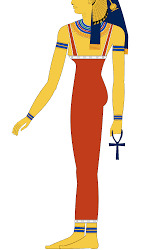
Mut-the-Great, "The Great Mother," is considered a primal deity, associated with the primordial waters of Nu from which everything in the world was born. Some legends say Mut gave birth to the world through parthenogenesis, but more often she was said to have a husband, the solar creator god Amun-Ra.
Mut was usually depicted as a woman wearing the double crown of the kings of Egypt, representing her power over the whole of the land. In art, Mut was pictured as a woman with the wings of a vulture, holding an ankh, wearing the united crown of Upper and Lower Egypt and a dress of bright red or blue, with the feather of the goddess Ma'at at her feet.
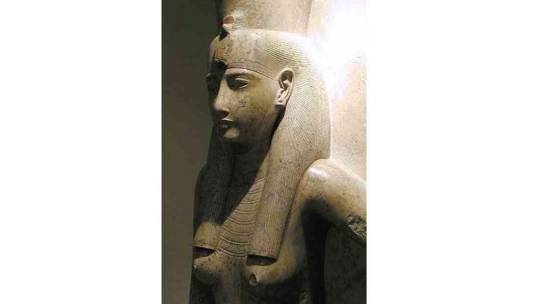
Mut never had the widespread popularity of some other goddesses, and was often an elite deity associated with kingly power. During the high point of her cult, the rulers of Egypt would support her worship in their own way to emphasize their own authority and right to rule through an association with Mut. Mut was worshiped in many ancient Egyptian festivals such as the Opet Festival and the Beautiful Festival of the Valley.
Her identity has merged at times with that of other more famous Egyptian Goddesses, such as Hathor and Sekhmet. As a result, Mut has been depicted as a cobra, a cat, a cow, and a lioness. However, she is frequently pictured with a vulture headdress, highlighting her role as a protective mother.
Surviving temples dedicated to Mut are located in modern-day Egypt and Sudan, reflecting her widespread worship. The center of her cult in Sudan became the Mut Temple of Jebel Barkal and in Egypt the Precinct of Mut Temple in Karnak. Surrounding the Mut Temple in Karnak, on three sides, is a sacred lake called the Isheru. During her rule in the Eighteenth Dynasty, the pharaoh Hatshepsut had the ancient temple to Mut at Karnak rebuilt.
Patricia Monaghan writes, “This creatrix, depicted variously as vulture, lioness, and crowned woman, was a punitive goddess in whose temple traitors were burned to death. She was associated with the period preceding the Nile’s annual flooding, when harvest had left the fields empty and the people relied upon stored foods. Some have theorized that she was an invented goddess, designed as a corollary to the important god Amun, but evidence shows her to be an early divinity of Thebes. (Ellis; Lesko; Müller; Wilkinson).”
During the reign of Rameses II a follower of the goddess Mut donated all his property to her temple and recorded in his tomb:
“And he [Kiki] found Mut at the head of the gods, Fate and fortune in her hand, Lifetime and breath of life are hers to command ... I have not chosen a protector among men. I have not sought myself a protector among the great ... My heart is filled with my mistress. I have no fear of anyone. I spend the night in quiet sleep, because I have a protector.”
Mut, her son Khonsu (who is a lunar deity) and her husband Amun formed The Theban Triad, which was particularly important during the New Kingdom period when Thebes was Egypt’s capital.
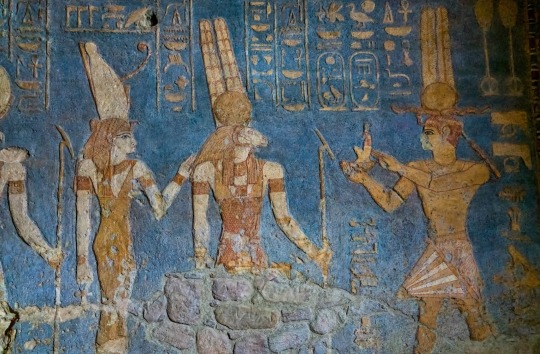
In the Payprus of Ani, there is a hymn to the Theban Triad:
“Hail to thee, O Amun, Lord of the thrones of the earth, the oldest of the gods, self-created, and creator of all things.
Hail to thee, O Mut, Lady of heaven, mistress of all the gods, the great mother, who gave birth to the sun.
Hail to thee, O Khonsu, the young, the beautiful, the beloved son, who brings light to the darkness and guides the traveler on his way.”
The following is a short excerpt of The “Crossword Stela” of Paser, circa 1150 BCE, found in the sacred Precinct of Mut is a hymn to Mut that can be read both horizontally and vertically”:
“Great of Sunlight, Who illumines the entire land with Her rays. She is His Eye, Who causes the land to prosper, the glorious Eye of Harakhty, the Queen of what exists, the Great and Powerful Queen, Life being in Her possession.
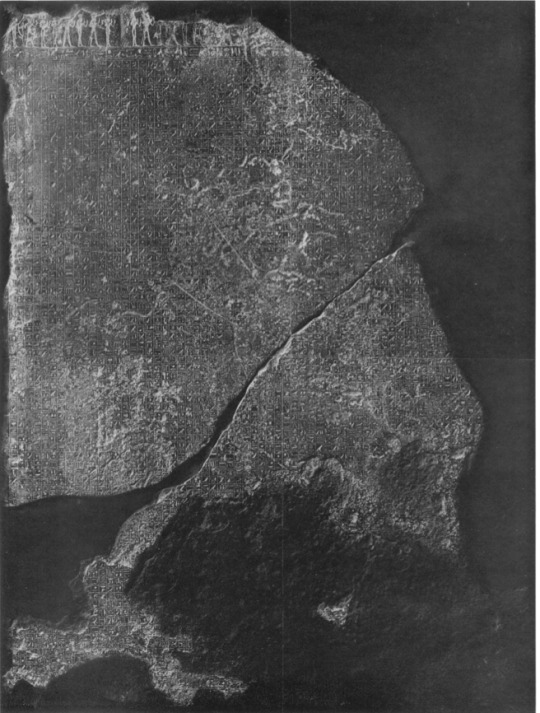
Great of Might, Her Eye has illumined the Horizon. As to the Ennead, Their hearts are glad because of Her, the Queen of Their joy in this Her name of Sky, for the spirits go forth within it because of Her.
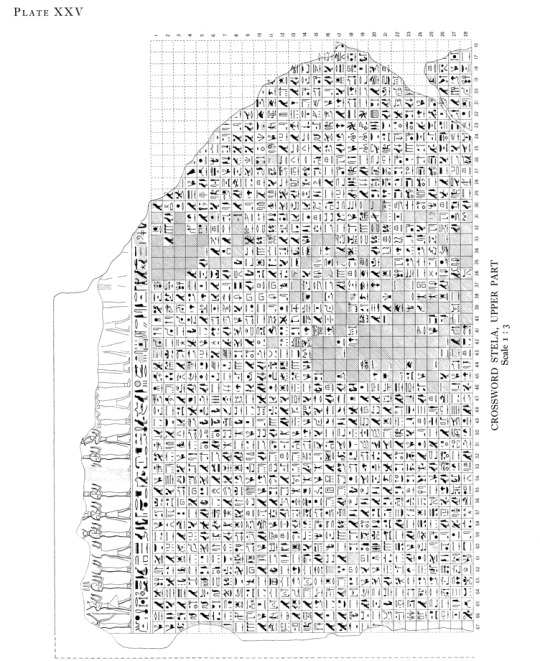
The Two Lands and the Netherworld thereof are light because of Her, when She has appeared in the sky. When She goes forth, all good plants are born. She Who rises early, existing in a multitude of forms, enduring as the Nurse.
Ra sees Her Might just as She sees by means of Him, since He knows Her Majesty’s beauty. The Goddesses shout for Her: food and provisions for Her, the Goddess in Uaset-Thebes.
READING FROM MUT:
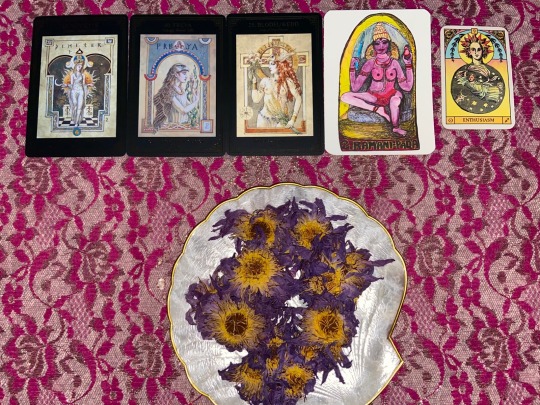
I asked Mut to describe herself and bring forth any messages she’d like to share.
16. Demeter: Devotion, Family Growth “Demeter, help me heal my grief and pain.”
40. Freya: Courage, Passion, Gifts “Call on Her for gifts of good and long companionship” “I will continue to be a beginning for all of my days, even until the very end.���
25. Blodeuwedd: Lady of the Nine Flowers She who refuses to be possessed. “Above all else, do not be possessed.”
Sri Ramani Pada: The Fulfiller of Wishes: “Sri Ramani Pada is a beautiful young woman. She is Icchanvati, the one who is wishful, because she has the powers of transforming through love any wish into a positive reality. She is a sensuous Yogini who frolics in the higher levels of consciousness.”
Enthusiasm: “This card describes someone who is energetic and outgoing, with a good sporty sense of fun and adventure."
Mut is a friendly Goddess, encouraging us to call upon her and build relationships with Her, regardless of our ancestry. She can transform our grief as well as be a companion to us as a face of the Divine Mother. She is particularly fond of being communicated with through intuition and astrology, and wants continued study of and research into Her myth. She is horrified by the destruction in Sudan and is with each of her children there that are suffering. Female devotees wishing for a baby are encouraged to ask her to aid in their fertility struggles. She feels the pain of all her children, and wants to help them restore their power and sovereignty through love.
More:
Etsy
Twitter: @SidraShakti
#vedic astrology#Goddess#Goddess Worship#Egypt#Egyptian Mysteries#divine feminine#sacred feminine#mother goddess#divine mother#hathor#egyptian gods#isis goddess#aset#inanna#venus#sekhmet#bastet#netjeru#kemetism#egyptology#ishtar#witchcraft#witches#witchcore#wicca#Mabon#shakti#tantra#durga#parvati
19 notes
·
View notes
Text
Echos Announce Outlast Records Signing and Releases New Single with Music Video "CAROUSEL"
Echos Announce Outlast Records Signing and Releases New Single with Music Video "CAROUSEL". #echos @EchosOfficial
Echos fans, rejoice! Today, the industrial-tinged, ethereal chanteuse has announced signing with her new label home, Outlast Records. In celebration of the news, Echos released a brand new single “CAROUSEL“. Accompanying the release is the official music video that serves as the visual counterpart to the evocative auditory journey of the single. Speaking about the track, Echos creatrix Alexandra…
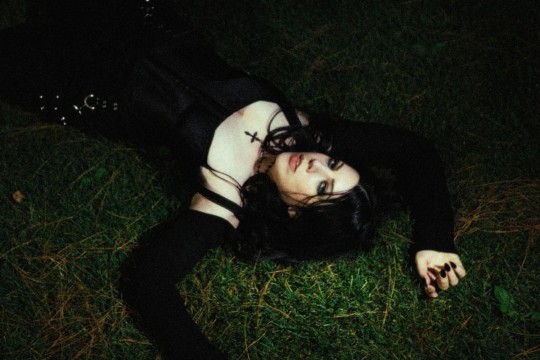
View On WordPress
7 notes
·
View notes
Text
The baby made a faint grunting noise before it did something unspeakable down the front of Sugafana’s shirt. Sugafana barely flinched. “I’ll be fine; I’ve done it before! Now if you’ll excuse me, I have to clean up and get this baby something to wear.”
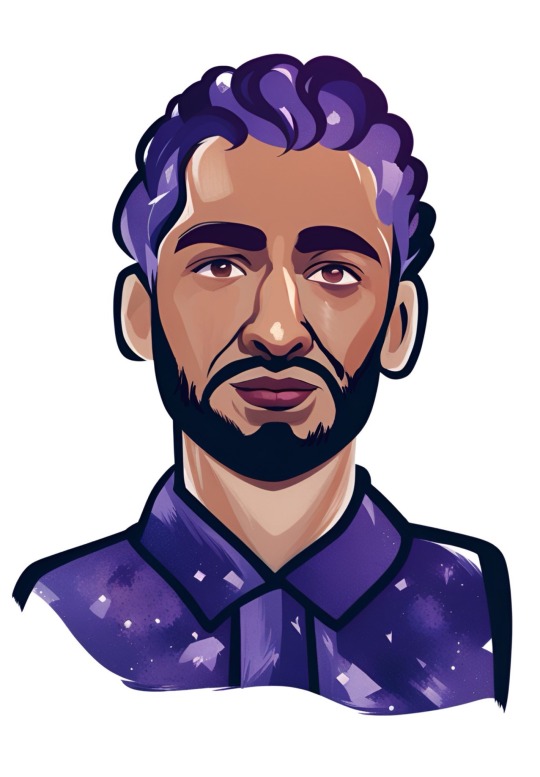
When Sugafana’s street was flooded by human rebels trying to short out the circuits of headphone guards, she didn’t take much. Just the essentials: a blanket, her water refillable condensation bottle, and her mother’s box of wedding jewelry. She also took her roommate.
“Afternoon, Nani,” Sugafana greeted her grandmother as she pushed aside the curtains that gave their small cave a tiny bit of privacy. Home was two rolled-up sleep mats on the floor with bedding, a box filled with clothing, and a small hissing and spitting machine standing in the corner. Natural grooves and holds in the lava stone walls had been used to display jars filled with buttons and thread. An embroidered tapestry depicting a little girl holding a cat hung from the ceiling.
“You’re back early,” Nani remarked, barely looking up from a dress shirt she was busy repairing.
“Yes, I found something expensive on the field,” Sugafana admitted, and Nani looked up, her hand still instinctively stitching away at the shirt's tear. Looking at Nani was like looking into her future. They both had the same round faces, amber eyes, and warm beige skin. Nani’s eggplant purple hair, however, had long ago turned ashy white with faint streaks of black. Her suspicious eyes were now surrounded by thick lines.
“You found a baby,” Nani said flatly, as Sugafana gently placed the baby in the center of the sleep mat.
“I found a maternity droid and sold it to Bappa; the baby was locked inside,” Sugafana replied as she shed her filthy shirt, switching it for a plain black blouse.
“We can’t keep a baby! I barely have time to keep up with all the clothes people drop off, and you’re out working twelve hours a day,” Nani grumbled. Many of the refugees in the camp had spent decades using A.I. appliances to clean and repair their outfits. Most of them found washing their socks baffling and panicked at the thought of torn trousers. Thankfully, before the war, Nani had worked as a historical preservationist at the Museum of Ancient Textiles.
“I never said I was keeping her, Nani! I’m taking her into the city to find her family,” replied as she grabbed an old scarf, wrapping it around the baby's bottom like a makeshift nappy.
“The city,” Nani said flatly, “It’s not like this camp has genetic testing pods lying around,” Sugafana pointed out. “We avoid the city for a reason!” Nani said, tapping her legs.
Nani’s legs hadn’t worked right since she caught Martian Polio as a child. The machines insisted that those who couldn’t run to generate power had to be “recycled.”
“I’ll be fine, Nani! I go to the city's teleportation pod every week for ice deliveries,” Sugafana said firmly, and Nani sniffed, glancing down at the baby.
“Odd little thing, isn’t she? Her hair is green! You don’t see that much around here,” Nani remarked.
“No, you don’t,” Sugafana admitted. Almost everyone she knew had hair that was either black or in various shades of deep purple. Green hair belonged to tourists from the outer planets. The baby's skin, however, was darker than hers, and she stirred slightly, her eyes opening a crack, revealing black eyes.
“She’ll need feeding,” grunted Nani, turning to the spitting machine in the corner. The Creatrix was an essential household item that could be found in almost any home. Using electrified sand from the moon of Titan and computer codes, it had the ability to generate almost any inorganic material. Sugafana’s Creatrix was a small portable camping one that her grandfather took on hiking trips. It couldn’t create clothing and only had fifty recorded codes, but it had its uses.
“I’m sure the machine still has the baby formula codes in it; we used to make bottles for your sister when she was tiny,” Nani remarked, and Sugafana pursed her lips together.
“Then that means those codes are at least twenty years old,” Sugafana pointed out, refusing to think about her sister.
“Codes are codes! You’ll need four bottles for a trip into the city and back, and an ever-cleaning nappy! Not a filthy scarf,” Nani said, scooping four cups of glittering black sand out of a flour bag.
“You need that sand for your pain tea, Nani!” Sugafana protested, and Nani waved her away with annoyance before punching in several numbers.
“I can handle leg twitches! You won’t be able to handle a screaming, filthy newborn,” Nani said firmly.
“Fine! But as soon as I get back, we are packing to head to Harris Park, and you will need to drink four cups of tea for that journey,” Sugafana said as Nani handed her an ever-cleaning diaper. Sugafana still remembered dressing her baby sister in one when she was ten years old. The diapers were supposed to clean a soiled baby automatically forever, but they tended to break down after a few weeks.
3 notes
·
View notes
Text
Amaz & Amazeanism
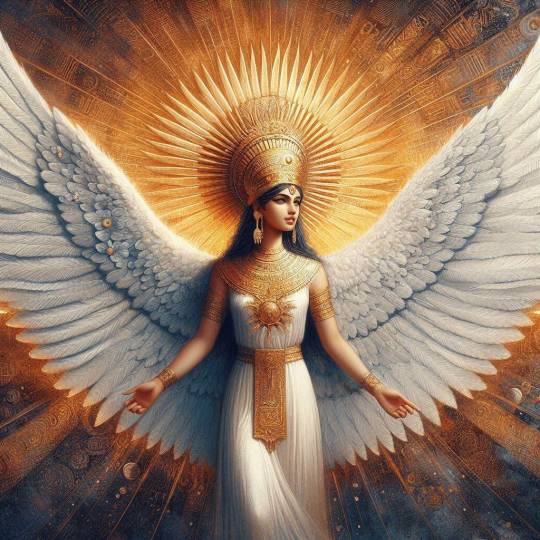
She Who Scorches, Empress of Heaven, Brightest One, The Winged Sun, the Solar Creatrix, Lightbringer
Amaz is one member of the Ziratriad, and the chief deity of South Mazea. She is the goddess who appeared to Solana Rayhelia, the first Queen of New Mazea, and told her to found a new Empire in Her name. Amazeans claim Amaz first emerged from the primordial darkness of the universe, and gave it light, order and purpose. She then birthed her two eldest children, Zoza and Nyra, to help her carry out her vision. She is the goddess of the sun, warfare, discipline, law and order, strength.
As a sun goddess, Amaz is both a loving Divine Mother who brings light and warmth to the world with Her rays, and also a vengeful warrior who scorches deserts and sets forests ablaze.
Out of the three goddesses of the Ziratriad, Amaz looks down upon men the most, as her son, Solandros, tried to usurp her and told men how to dominate and rule over women, which was never Amaz's plan. Solandros's plan was thwarted and he was not able to usurp the Solar Throne, but much damage had already been done as the world became extremely patriarchal. Therefore, the Amazeans of South Mazea treat men with the most scorn out of all of the four corners of the Empire.
Amazeanism is also the most conservative out of the three religions. Female worshippers are banned from copulating with men for reasons other than procreation, which must be approved by the Queen. Women may take one female lover, but must be devoted to her and her alone. However, this doesn't mean this is always exercised as not all women of South Mazea are as devout as others. Priestesses are banned from romantic and sexual relationships all together as they must be wholly focused on the Ziratriad, and besmirching this rule will result in exile if its with another female, or execution if it's with a male.
Amazeanism greatly values discipline, physical strength and prowess, and all worshippers are expected to remain as physically fit as possible. Amaz is often worshipped through music, and so priestesses of Amaz are expected to be proficient in the the musical arts. Moreso than the other two religions, Amazeans record writings in holy books a great deal, and so priestesses are expected to be compelling writers. They are also expected to train in wellness so they can provide soothing to other members of the queendom and so they can quiet their minds to focus only on Amaz and the other Goddesses.
Her holy colours are orange, gold and yellow, like the rays of the sun. She is depicted as a woman haloed by or clothed with the sun, and huge white wings. Her holy animals are eagles, horses and lions. Her holy metal is gold.
1 note
·
View note
Text
Names held power. Everyone knew that.
The English royal family were the first to study the phenomenon, and put it to good use by pulling any Charleses out of magic schools and training them in the palace. The Chinese were a bit behind, placing undue focus on crafting the name and less its legacy, although it's said the imperial court knew the method was a dud. Little is to be said of the Germans, who mandated children be named ‘Firemancer’ or ‘Deathbringer’ during World War 2, which failed miserably once the name lost all meaning.
Names held power. But it was only after the Institute of Mythology revealed to the public how that Merlins and Hecates began springing up like weeds. A name contained the legacy of all those who shared it, and so the more powerful your forebears were, the more powerful you would be. The legacy need not be well known, but it must have been true; so it was hilarious when a columnist advertised a way to ‘jailbreak’ the system by using the names of fictional heroes, and it was equally hilarious to see students with last name Sue and first name Mary sulking because they couldn't cast a fireball.
Eventually, though, the wave of excitement died down. The proud named their children after their family’s clan to carry on their legacy; the weak named their children after famous wizards to give them a chance of redemption; everyone else named their child Merlin. For it was a simple and elegant name, with a simple and elegant legacy, well respected but with no hijinks or fate-dooming anomalies.
St. Paul’s School for Wizards had over two hundred and thirteen Merlins in total, not counting staff and faculty. It had become a gambling game for them, really, to look at the CVs of any thirteen year-old and bet if it would be Merlin. Usually the people who bet on Merlin won. Which is why it came as such a surprise that resume letter #1008 was Bob.
Bob was brought straight into questioning by the headmaster. He could perform all the spells for a wizard his age: apparition spells, cantrips, a protective charm or two. But St Paul’s wasn't just any old school, and when subject to more rigorous testing, he barely passed half the tests they threw at him. Completely expected. They sat a sweating and tired Bob down and asked him a few questions: yes, that was the name he was given; no, he did not bring his wand with him because it was confiscated; yes, St Pauls was the only school he applied to.
With each answer the teacher's eyes furrowed. There wasn't any law dictating what you could or couldn't name your children, and yet this seemed to veer on the edge of child abuse. An analyze spell showed he was physically and mentally sound, however. There were reasons to choose one name over the other; the stronger the legacy of a name was, the more constrained a person's field of magic could be. Powerful names reduced a person's magical ability if they tried to surpass them, and fate and fortune alike could be inherited through names. Yet Bob didn't seem like he would surpass Morgan le Fey anytime soon, and Merlin had nothing but a good life.
They decided to let him in on the condition that he would be monitored at school. Bob accepted. That gave the school board time to dig through his legacy. He was the son of Kainotomia and Creatrix. The two were blessed with entrepreneurial talents, and Creatrix had a ‘try it out for yourself’ spirit from C. Smith five decades ago. A perfectly fine name for Bob to inherit, more so given that his name came up blank everywhere. No wizard or alchemist, no witch or sorcerer ever showed up in the Runes 500 or even 5000. They scavenged through historical records, searched through myth and legend. No Bob. The only lead they had was that Bob was an incredibly common name upon the magically deaf.
The biggest surprise came when Bob came into class brandishing a gun, not a wand. Not because it was dangerous, mind you; in fact it was quite the opposite. Magic and technology are like oil and water, and combining the two leads to both failing. Any danger the bullet would've posed was nullified by all sorts of wards enveloping the school. Yet when the teacher called Bob to demonstrate a touch spell amidst sniggers and whispers, Bob simply pointed his gun and pulled the trigger. The bullet was a fiery green.
It soon became clear, among blazing Aerosol sprays and potion-brewing coffee machines, that Bob was in St. Paul’s for a very good reason. Magic people did magic and tech people did tech, yet by inheriting the legacy of millions of smartphone users, gun owners and car drivers, Bob was able to bring the two words together with sheer force. No fate to limit him, no shadow to break free of. He was taken out of normal lessons and privately tutored by whatever teacher could wrap his head around the boy. His name spread through campus, and within weeks he would emerge from the school's private study to a whirlwind of juniors with too much free time on their hands. With each invention - a spell-generating AI, computers that never overheated - Bob’s magical journey soared to new heights. He smashed the final by wearing a set of robot arms to cast incantations at twice the speed, getting an A++ and sending the school board into a heated debate about what it really meant to be proficient in magic. But it was soon decided that just like wands and amulets, Bob’s tools were just that. Tools. His magic prowess was unstoppable.
But if you ask him about what he's most proud of, he'll simply shrug. To him, it was the foresight of his parents and maybe the benevolence of the headmaster that got him this far. He’s simply a boy with a few tricks up his sleeve. Really press him for an answer, though, and he'll point to the air-conditioner blasting icy mist with the slightest smile on his face.
Names have power, so the more people who share the same Name, the more powerful they are. The Wizard School was prepared for their 213th Merlin. What they weren’t prepared for was their first Bob.
3K notes
·
View notes
Text
The Most Anticipated Albums Of 2023 (Part Two)
Check out the first half of the most anticipated albums of 2023, featuring @johnnyalligator, @StoryoftheYear, @MCRofficial, @augustburnsred and @andrewmcmahon!
This is part two of four. If you haven’t read part one yet, check it out here. In 2023, we’re getting several great albums some several great bands and artists, but out of all the albums that are coming out this year, these are the ones you need to keep your eyes on. Here are the most anticipated albums of 2023, in no particular order. Andrew McMahon In The Wilderness Album: Tilt At The Wind…
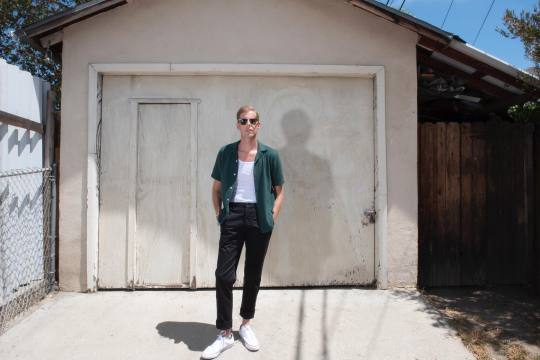
View On WordPress
#&039;68#7 Seconds#Adele#Alice Bag#Andrew McMahon In The Wilderness#August Burns Red#BAILEN#Balance And Composure#BANNERS#Big D And The Kids Table#Blackened Recordings#Blink-182#Boys Night Out#Carly Rae Jepsen#Citizen#CLIFFDIVER#Columbia Records#Creatrix Records#Eighteen Visions#Erra#Fantasy Records#Flogging Molly#Florence + The Machine#Full On Mone&039;t#Galactic Empire#Get Better Records#Good Fight Music#Green Day#High On Fire#John Butler Trio
0 notes
Text
Reconnecting with the Divine Feminine

I don’t think it’s groundbreaking or controversial at this point to say that all three Abrahamic religions are mostly patriarchal. Sure, we can talk about the veneration of the Virgin Mary, or the woman prophets in the Tanakh, or women saints in Islam. At the end of the day, though, we cannot overlook the fact that in Christianity, Judaism, and Islam, God is a man. Since 31% of the world’s population identify as Christian and 23% identify as Muslim, that means over half of the people on Earth are completely disconnected from the feminine side of divinity.
Ironically Judaism, Christianity, and Islam are among very few religions that don’t embrace a feminine aspect of divinity. Patriarchal religion is treated like the norm in most modern cultures (again, largely because of the dominance of Christianity and Islam), but it has definitely not been the norm throughout human history. The Goddess, the Divine Feminine, has been a prominent part of human spirituality since before recorded history.
In ancient Sumer she was Inanna, the Queen of Heaven. In Egypt she was Isis, Lady of the Sky, Great of Magic, and Hathor, Lady of the West, and Sekhmet, Mistress of Fear. In Hinduism she is Shakti, the feminine principle that moves the universe. In Japan she is Amaterasu, the Great Illuminating Deity, and Izanami, the creatrix who rules the underworld. The Divine Feminine has taken all of these forms at different times and places, among many, many others.
Even the Abrahamic religions haven’t always been solely focused on masculine divinity. There is significant evidence that the Abrahamic God was originally part of a larger pantheon before becoming the sole object of worship in Israel and Judah. As part of a polytheist system, he had a consort, a goddess named Asherah. Rabbinic literature refers to the divine presence of the Jewish God as “shekinah” — interestingly, this is a feminine word, implying that this aspect of God is feminine.
The removal of feminine divinity from Christianity largely occurred during the fourth century, when Roman Christianity beat out other traditions as the sole “correct” Church. Before this some Christian groups, notably those in North Africa, had worshiped God as both Father and Mother — a masculine/feminine dyad, rather than the masculine trinity worshiped in Rome. Other groups identified the Holy Spirit as feminine, creating a trinity of Father, Mother, and Son. (Interestingly, these family triads were also common in Egyptian paganism.) When the Nicene Creed was created in 325 to standardize Christian belief and practice, it excluded these interpretations by affirming belief only in “God, the Father Almighty” and “Jesus Christ, the Son of God” and removing all mentions of God the Mother.
All of this does not invalidate the genuine, life-changing spiritual experiences people have had with modern Judaism, Christianity, or Islam. It does, however, prove that patriarchal religion is the exception, not the rule.
Modern paganism’s acceptance and veneration of the Divine Feminine is a large part of its appeal for many converts, especially women, genderfluid, and nonbinary people who do not see themselves represented in the mythology and art of patriarchal religion. The Divine Feminine is present in all pagan religions, though She takes different forms in different faiths.
In monist pagan paths like Wicca, the polarity of Goddess and God is seen as one of the primary ways deity makes itself known to mankind. In the words of Scott Cunningham, one of Wicca’s most influential authors, “The Goddess and God are equal; neither is higher or more deserving of respect… The Goddess is the universal mother. She is the source of fertility, endless wisdom, and loving caresses… She is at once the unploughed field, the full harvest, and the dormant, frost-covered earth.”
The Goddess and the God balance and compliment each other, and this balance is at the core of many neopagan religions. (There are some traditions that exclusively worship the Goddess, but we’ll talk more about that in a future post.)
In polytheist paganism, the Divine Feminine is present in the form of various goddesses who rule over different aspects of life and nature. It is not uncommon for polytheist pagans (or monist pagans, for that matter) to work with multiple goddesses, even goddesses from different historical pantheons. Some goddesses are explicitly associated with certain aspects of womanhood — for example, the Greek goddess Artemis is associated with virgins and young girls, while Demeter is associated with motherhood.
In many (but not all) polytheist systems, there is an emphasis on balance between gods and goddesses. One of my favorite examples of this is the marriage of the Morrigan and the Dagda in Irish mythology. The Morrigan, goddess of war, magic, and death, is married to the “good god” of life, fertility, and knowledge. Their union represents a balance between opposite, complimentary forces.
This brings us to another point I want to make, while we’re on the subject of the Divine Feminine: not all feminine divinities are passive, maternal, fertility goddesses.
In Western culture, women (and, by extension, feminine deities) are seen as the passive or receptive sex. This is largely a product of Victorian England, not an ancient truth.
Without knowledge of sex chromosomes, hormones, or the complexities of gender, Victorian thinkers developed a theory that men had a “katabolic” nature that was constantly releasing energy, while women had an “anabolic” nature that was constantly receiving and storing up energy. This concept of gender greatly influenced Western occultism and can be seen, for example, in Gerald Gardener’s conception of the Goddess as the passive recipient of the God’s energy.
This is a relatively new and very Western idea. In Hinduism, for example, Shakti is both the feminine principle and the energy that moves the cosmos. In the words of author Kavitha Chinnaiyan, “there is nothing in creation that isn’t a manifestation of Shakti.” Shiva, the masculine principle, is unchanging awareness — it is Shakti who possesses the dynamic energy necessary for creation.
I am by no means encouraging pagans to appropriate Hindu concepts. My point here is that no gender is entirely active or entirely passive, which is why so many cultures interpret gender in so many different ways.
Even within systems like traditional Wicca, which operate within a strict gender binary, neither gender can be completely tied down. In their book A Witches’ Bible, traditional Wiccans Janet and Stewart Farrar acknowledge that the “masculine = active, feminine = passive” model is an oversimplification. They use the example of an artist and muse. The (feminine) muse “fertilizes” the (masculine) artist, who “gives birth” to the resulting art.
Personally, I see the masculine/feminine polarity as a constantly shifting dynamic, with both sides giving and receiving energy all the time. Which side of the polarity is more active or passive depends on the situation.
Being pagan does not mean dedicating yourself to the worship of gender binaries, and it does not mean you need to uphold those binaries. God and Goddess are only two of many possible expressions of the Divine, just like man and woman are only two of many possible gender expressions.
Monist pagans see the God and Goddess as two halves of a greater, all-gendered whole. Polytheist pagans may worship gods and goddesses who fall outside of the gender binary such as the Norse Loki or the Egyptian Atum. In either case, divinity is seen as encompassing all possible gender expressions, not just cis man and cis woman.
The erasure of the feminine from Western religion and mythology means that the nonbinary nature of some deities is often downplayed or erased completely. (You’d be hard pressed to find a mythology book that doesn’t use he/him pronouns for both Loki and Atum.) Reconnecting with the Divine Feminine opens the door for other divine expressions of gender.
The end result of this acceptance of feminine and nonbinary divinity is a religious community built on equality between all gender expressions. No one is closer to the gods because of the anatomy they were born with or the gender they present as.
This paves the way for a religion where no one’s worship is restricted because of their gender expression. It allows for priests, priestesses, and priestixes. It allows everyone to fully participate in the rites of their faith, on equal footing regardless of gender or pronouns. It also creates an environment where practitioners feel comfortable exploring issues of gender and sexuality, knowing that they will not lose the support of their community if their identity changes.
Resources:
The Gnostic Gospels by Elaine Pagels
Wicca: A Guide for the Solitary Practitioner by Scott Cunningham
The Morrigan and The Dagda by Morgan Daimler
“Victorian Theories of Sex and Sexuality” by Elizabeth Lee, Brown University
Shakti Rising by Kavitha M. Chinnaiyan, M.D.
A Witches’ Bible by Janet and Stewart Farrar
Casting a Queer Circle: Non-binary Witchcraft by Thista Minai
#paganism 101#pagan#paganism#goddess#divine feminine#wicca#wiccan#feri#reclaiming#celtic paganism#irish paganism#hellenic polytheism#hellenic paganism#hellenismos#religio romana#roman paganism#heathenry#norse paganism#norse polytheism#kemetic polytheism#kemetic paganism#eclectic pagan#witchblr#witch#witchy#baby witch#christian witch#long post#my writing#mine
240 notes
·
View notes
Text
Inanna – Sumerian Mother Goddess, Queen of Heaven and Earth
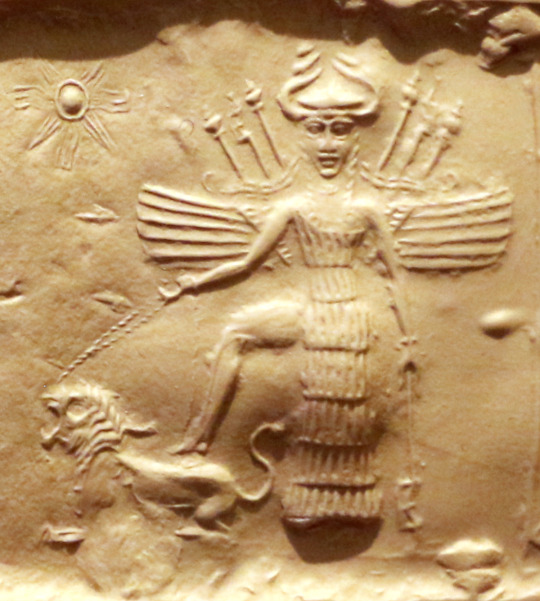
One of the longest lasting Goddesses from the ancient world is Sumer’s Inanna, who was revered in the Middle East for over 4,000 years. And even today in modern Islamic Iraq Inanna’s emblems of the reed knot and the date palm continue to have meaning to the people. [1]
Inanna’s origins are very very old and date back well into the Neolithic age. It is believed that the Goddess-revering Al ‘Ubaid culture brought Her imagery with them when they settled in the region south west of the Euphrates river as early as the 6th millennium BCE, i.e. 8,000 years ago. Her earliest temple was discovered in Uruk (Erech), Inanna’s main and longest lasting place of worship, and dates back to about 5,000 BCE.
In the early days of Her worship Inanna was still seen as the all-encompassing Mother Goddess. She was still revered as the source of the Upper and Lower Waters, as the Queen of Heaven, Earth AND the Underworld. As human consciousness – probably due to external factors – changed over the millennia, Inanna’s powers diminished. At first She was split into the Goddess of Life, represented by Inanna, and the Goddess of the Underworld, represented by Her sister Ereshkigal. Eventually She would be given a father who was said to have given Her Her powers.
According to earliest records from the 4th millennium BCE Inanna’s grandmother is Nammu, the primordial Goddess of the Sea. The Babylonians knew Her as Tiamat. Nammu created Heaven and Earth and gave birth to Ningal / Ninmah, the Goddess as the Moon. Ningal / Ninmah Herself created the first people. She also gave birth to Inanna who manifests as the planet Venus, and as Inanna is the daughter of Ninagal / Ninmah, so is Venus the daughter of the Moon.
True to Her heritage, Inanna is the Goddess of the Morning and Evening Star as well as the Moon. Her imagery include the lunar crescent horns and the 8-pointed star, the rosette, which represents the planet Venus. Her headgear consists of a horned crown enclosing a cone, which is symbolic for the sacred mountain.
Inanna is often depicted with wings and a serpent-entwined staff. This imagery tells of Her roots as an ancient Bird and Snake Goddess, the Creatrix of the Upper and Lower Waters and the Goddess of Life, Death and Renewal.
Inanna is often dressed in blue which, just as Her lapiz jewels, reflects the blue of the Upper Waters or “The Deep” as the Sumerians referred to space. In fact they saw the sky as being a manifestation of the Goddess with the clouds being Her breasts and the rain Her milk. Inanna’s necklace is described as the rainbow and Her girdle as the zodiac.
Inanna is associated with the gate to cow-byres and sheepfolds, the gate representing Her vulva and the cow-byre or sheepfold Her womb. In ancient Sumer two bundles of reeds with curved ends (“Inanna’s Knot”) were placed at the entrance of Her storehouses and later Her temple Eanna in Uruk (Erech) to symbolise the Goddess.
Inanna’s sacred animals include the lioness and the cow, the former representing Her powers – She is able to tame wild lions! – and revealing Her as Goddess of the Animals, while the latter represents Inanna’s life-giving and nurturing aspect.
In her life-giving aspect Inanna’s birds include the white lunar dove and the swallow. In Her aspect as Death-Bringer She is associated with the viper and the scorpion, but also the owl, one of Her names being “nin-ninna” or “Divine Lady Owl”
Inanna, the Great Mother Goddess of the Sumerians has many titles such as:
“Queen of Heaven and Earth” “Priestess of Heaven” “Light of the World” “Morning and Evening Star” “First Daughter of the Moon” “Loud Thundering Storm” “Righteous Judge” “Forgiver of Sins” “Holy Shepherdess” “Hierodule of Heaven” “Opener of the Womb” “Framer of All Decrees” “The Amazement of the Land” “The Green One” “She of the Springing Verdure” “Queen of Stall and Fold” [2]

Although Inanna is a Goddess of Life and Death, later mythology passes Her dark moon aspect on to Her sister Ereshkigal who once having been a Corn Goddess becomes the Goddess of the Underworld. This changeover has much to do with a changing attitude towards death and the life cycle. While during the Neolithic and the early Bronze Age life was seen as cyclical with death not being the final end but rather a resting stage before rebirth, in later years as humanity distanced itself more and more from the natural world, the understanding of the Underworld changed from it being the womb of the Goddess to a place of no return. Ereshkigal is the Ruler over the Sumerian Underworld. However, some of the old cyclical beliefs remained even during the later Bronze Age, as late Sumerian mythology tells of how Ereshkigal gives birth to new life.
In Her capacity as life-giving Goddess Inanna is all about fertility and abundance. This is the aspect of Her that today we most associate with the Goddess as Venus.
As Queen of Earth Inanna is Goddess of grain, vine, date palms, cedar, the sycamore fig, the olive and the apple tree. Her temple towers known as ziggurates were large storehouses from where Her priestesses would watch over the fields, fisheries and livestock. They would accept donations from the people and share them with everyone. All incomings and outgoings would be recorded by them on clay tablets using reed styluses.
The High Priestess or Entu was seen not just as Inanna’s representative on Earth, but as the Goddess’s incarnation. Every autumn at the new year she would select a young man as her lover-consort to celebrate the Sacred Mating (Greek “Hieros Gamos” = Sacred Marriage). Through the love-making of the Entu and the man, who would become the king for the next year, the fertility of all life on Earth would be assured. Any children that were born of this union were considered to be half divine and half human, just as the hero Gilgamesh was thought to have been.
Just as Inanna is the Hierodule of Heaven, so were Her priestesses the hierodules of Earth. Hierodule is a Greek word that means “sacred work” or “servant of the holy”. Fertility and life is how the Goddess manifests Herself on Earth. [In most cases] Sexuality is the means by which fertility and thus new life comes about. In order to honour Inanna and to help keep the Earth a rich and flourishingh place, Her priestesses would re-enact the sacred act of lovemaking with Inanna’s worshippers at Her temples. The feelings of ecstasy experienced were seen as a divine state of bliss. Unfortunately, when Sumer with her long-hidden secrets was discovered not so long ago, the worldview of the archaeologists and anthropologists was clouded by Christian teachings who misunderstood the sacred role of hierodule and called Inanna’s priestesses “temple prostitutes” or “harlots”.
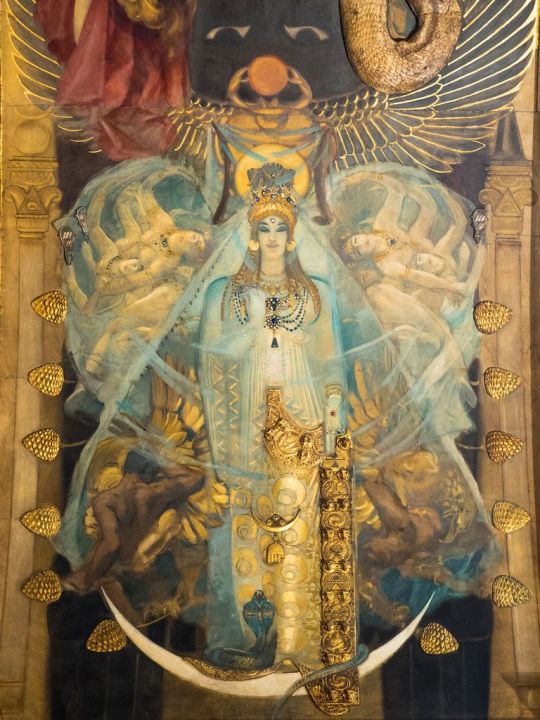
Inanna is the Queen of Heaven, her celestial manifestations being the Moon and the planet Venus. Like Isis in Egypt the star Sirius is sacred to Her as are the constellations Virgo and Scorpio.
Inanna is the Goddess of Death and Destruction. She is a Goddess of the Storm who represents the raw, unbridled destructive power of nature. Inanna is also known as “the Dragon” and is depicted as such with venom spewing from its mouth. In Her capacity as Destructress She is also represented by a lion-headed thunder bird known as “Imdugud”. [3]
Inanna is the Goddess of Natural Law and Justice. She is the Bringer of the “me”, the Sumerian Tablets of the Law. Inanna is just and compassionate. Her gifts to humankind include civilisation, wisdom and prophesy. [4]
As said before, at the start of the Bronze Age humans still saw themselves as being completely part of nature and therefore the Goddess. However, as time went by and our consciousness and self-awareness increasingly developed we felt more and more separate from the source. While initially humans saw death not as an end but just as another step on the cycle of life, with the increasing separation from nature came the realisation that while life in general continues indefinitely, the inidividual life will not. The Ancients described this in terms of a permanent life source – Ka soul or Zoe – and the many varieties of temporary life – Ba soul or Bios – the latter of which was believed to return to the source after death. The permanent life source was experienced as the Goddess and that of the temporary life force that is born from Her and returns to Her after death was represented by Her son-lover-consort. The life and death of the son-lover contains the lunar myth of birth, growth, decay and death. It also represents the Wheel of the Year with the god or son-lover being symbolic for the vegetation that grows and dies with the seasons. By the end of the Bronze Age rebirth was no longer envisioned for the individual but reserved only for goddesses and gods.
In Sumerian mythology this story is told through the birth and death of Dumuzi, the son-lover of the Goddess Inanna. His name literally means “faithful son”, but being a vegetation god he was also referred to as “The Green One”. He is a shepherd, “Lord of Life” and “Lord of the Net”. As “Bull of Heaven” the bull is sacred to him, but so are the ram and the goat. In Sumer the date palm which was the Tree of Life was associated with Dumuzi, as were grains, especially barley. Inanna’s son-lover was identified with the harvest and all the produce that was stored inside Her temples.
Every year in the autumn when in Mesopotamia the fertile raining season started, Inanna would join with Dumuzi in the rites of the sacred mating / marriage. This would ensure the fertility of the land. At the onset of the summer in July when the Sun would dry up the land and burn the crops, Dumuzi would die and enter the Underworld.
The story of Dumuzi’s death is interlinked with Inanna’s Descent. As said before, at some point during the Bronze Age people stopped believing in the uninterrupted cycle of life and death for themselves. The Underworld no longer was the womb of the Goddess, but instead became “The Land of No Return”. However, Inanna’s priestesses were aware of this split between the Upper and Lower Waters. Just as in ancient Greece every year many Sumerians would re-enact the descent of the Goddess into the Underworld in order to reunite their own consciousness with their unconscious and regain completion. It was a shamanic journey for both the Goddess and Her initiates.
The story of Inanna’s Descent involves the Goddess visiting and re-uniting with Her dark self or sister Ereshkigal. It is very much a lunar myth of the dark moon. On the way Inanna encounters seven gates – the number of days of the waning moon – where She has to give up the seven regalia of Her office. When She finally meets Her sister, She dies and has to hang on a hook for three days – the number of days of the dark moon. During that time Ereshkigal, the Dark Moon Goddess or Inanna’s dark moon aspect, gives birth to new life. Eventually the Queen of the Underworld agrees to let Inanna return to the world above, but only on the condition that She can find a replacement for Herself. Inanna returns to Heaven and Earth where She finally chooses Her Son-Lover Dumuzi to take Her place, as unlike everyone else he did not grieve for Her and instead enjoyed his time on Inanna’s throne.
Much of Sumerian mythology was adopted by the Babylonians where She was known as Ishtar and Her son-lover as Tammuz. Eventually the story of the Goddess and Her son would make its way into Christianity where to this day millions of people celebrate the birth of Jesus at Christmas and his death and resurrection at Easter. Mary to this day is celebrated by many as the Mother of God.
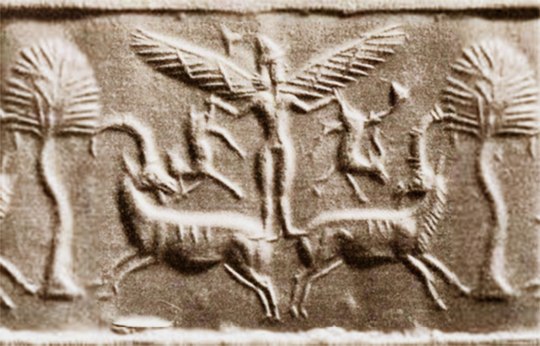
Unto Her who renders decisions, Goddess of all things, Unto the Lady of Heaven and Earth who receives supplication; Unto Her who hears petition, who entertains prayer; Unto the compassionate Goddess who loves righteousness; Ishtar the Queen, who suppresses all that is confused.
To the Queen of Heaven, the Goddess of the Universe, the One who walked in terrible Chaos and brought life by the Law of Love; And out of Chaos brought us harmony, and from Chaos Thou has led us by the hand.
– Babylon, Eighteenth to Seventh Century BCE
298 notes
·
View notes
Text
Crone Goddesses
After investigating a feminine trinity symbol on Pinterest, I’ve discovered the triplicate goddess (feminine/pagan version of the Holy Trinity):
- Maiden (spring/summer, flowers, bloom, youth, innocence)
- Mother (fertility, teaching, kindness, motherliness)
- Crone (time, destroyer/creatrix, age, death, change, wisdom)
I identify with the Crone, absolutely. I think this might lead to the answer to one of my main questions: who do I invoke?
I’ve since learned there’s many crone goddesses - Hel, Hecate, et al - and I’m drawn to Hecate, but I’m also percolating an idea of a general “crone” in my mind. The name Cronin came to me (for obvious reasons).
The Crone appeals for so many reasons:
Most of the obstacles in my life revolve around time (running out of it)
I’ve had “old” hobbies since I was young (knitting)
I’ve only been getting “older” (never liked partying that much, learning to shun fashion in favour of basics that work)
I studied archaeology (the material passage of time) and there’s a philosophy to the practice that states “to create, we must destroy” - i.e to record things properly it’s necessary to ruin its state, but at the same time the recording becomes a part of its history
I’ve always thought, if I act “old” now, I’ll be young until I die
I’m attracted to old places
I love Halloween, spooky stuff, death, ghosts... all of it
So this is the beginning of my journey to connect with the Crone(s). Wish me luck!
14 notes
·
View notes
Photo

Now More Than Ever – The Echo – Los Angeles, CA – March 16, 2023
Brand new albums call for record release parties – and the emerging band Now More Than Ever held their first show in Los Angeles on Thursday to celebrate and perform their debut album Creatrix in entirety.
Led by the lead singer of The All-American Rejects, Tyson Ritter took the stage of the Echo adorned with pink eyeshadow and dressed in a flight suit in reference to their new music video for "Tragedy." Joined by bandmates Isaac Bolivar on guitar and Scott Chesak on keys, the show began with their single "Don't Rush, Don't Wait."

Being four years in the making, the band expressed gratitude to the fans for being there for the sold-out show as their debut album came out minutes before.
Tyson spoke as an advocate for the transgender community and brought out actor Mason Alexander Park to perform a song together that he wrote for the community.
The crowd went wild for guitarist Isaac's father and saxophonist, who joined his son on stage for their song "Candle," and we definitely think too much of Now More Than Ever is never enough.
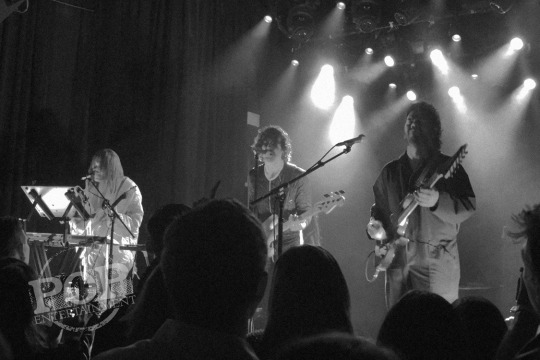
Other fan favorites included "Tragedy," "D-E-A-D Together," and "Heart To Heart." However, the nine-track album arguably has no skips, fresh angsty pop rock that we love.
Be sure to check out Now More Than Ever on their first tour this year and their new album Creatrix!
Copyright ©2023 PopEntertainment.com. All rights reserved. Posted: March 19, 2023.
Mia Jessie
Photos by Camille Jessie © 2023. All rights reserved.
0 notes
Photo

Hey My Angel Rockers!!! Please join Me TONIGHT, Monday, January2nd/2023 from 5pm-7pmCST/6pm-8pm EST when I have My very Special Guest Dianne Doyle-Lynch on Tonight. Happy New Year! Tonight, please join Me as we welcome Fellow Canadian Dianne Doyle-Lynch who is an amazing author, osteopathic practitioner, meditation retreat leader & creatrix of Blue Moon Healing & Wellness as well as sharing many words of wisdom on her beautiful TikTok channel. We’re going to be discussing her incredible books, including her latest “Realm of Zen” , her work & so much more! You do NOT want to miss this! WATCH The Angel Rock LIVE here: https://youtube.com/c/UFOParanormalRadioUFOParanormalRadio , https://youtube.com/channel/UCONfaKbz3Ju4eTyBw5Oo7OA https://youtube.com/c/TheAngelRockWithLorileiPotvin https://www.facebook.com/UPRNTalkRadioNetwork , https://www.facebook.com/JoeMontaldoUFOUndercover , https://www.facebook.com/ICAR1Official To BOOK a Psychic, Medium Reading, Crystal Reiki Healing Sessions, Akashic Record Readings &/Or Mentoring Sessions with Myself; please message Me @: http://www.facebook.com/TheAngelRock or: [email protected] as well as Subscribe to My YouTube Channel here: http://www.youtube.com/c/TheAngelRockWithLorileiPotvin You can reach Dianne here: https://linktr.ee/Bluemoonwyld https://www.instagram.com/p/Cm7GtsIudHA/?igshid=NGJjMDIxMWI=
0 notes
Text
"Everyone, make way! The Apple queen needs to rest before the grand ball tonight," Bridgadeiro screamed to the universe in general.
"Oh, Goup, we have to actually go to the Apple Ball now! And Revati will need a new dress," Mrs. Bun seemed to realize.
"I don't think we all have to go; nobody's forcing us," Vanilla said mildly.

Half an hour later, Revati was back in the Bun family's kitchen, carefully slicing open each of the apples. Bridgadeiro had wandered off with his father to set up "the flower fireworks" for the ball.
"Let's see, you have broad shoulders with a large bust, very small hips," Mrs. Bun, who was circling Revati, remarked.
"She does have great legs, probably from walking everywhere," Vanilla added from where they appeared to be examining a bunch of dress designs on the wall.
Revati merely ignored them and used a fork to carefully pry out another Martian Opal.
"What pattern codes do we have? She can't show up in that sundress," Mrs. Bun asked.
"We could go with the satin wrap-around I wore last Australia Day," Vanilla remarked as Revati grabbed the last apple.
Twelve apples, four opal seeds per apple.
"No, the two of you will look too similar! I have a pattern I wore to granny's funeral," Mrs. Bun replied.
"A funeral dress? Really?" asked Vanilla.
Forty-eight Martian fire opals.
"It's long and decent," Mrs. Bun pointed out. The fire opals glimmered, still covered in the remnants of sticky pulp.
"You don't have to keep the seeds; they're just weird pattern glitches! One time we created a bunch of tomatoes with gold seeds," Mrs. Bun said to her.
"I'm keeping them," Revati said, scooping them up.
One of the first history lessons Amma taught Revati was the legend of the Mars rover.
"Long, long ago, when our world was barren and desolate, a robot from old Earth came. The robot's name was Curiosity, and for eons, he rolled across the dusty red surface. Then one night, he discovered in a dry crater the water opals," Amma would whisper.
"We could fuse them into a necklace using the creatrix; that would add some glamour," Vanilla mused.
"Fine, just don't chip them! Otherwise, we won't be able to read them later," Revati said, handing her the opals.
"Read them?" Vanilla asked, faintly confused.
"Martian fire opals have a natural property where you can record information! Obviously, I was given these for a reason," Revati said.
"See, if she wears the shiny seeds with the funeral dress, she will look perfectly fine," Mrs. Bun said.
Suddenly, the kitchen door swung open dramatically.
"This year's apple queen is not wearing a funeral dress to the grand apple gala!" Auntie Magdeline declared, marching in carrying a bundle of red shimmering fabric.
Auntie Magdeline shook the fabric out, revealing a scarlet ballgown. The shiny silk was covered in apples made out of sequins and beads. The sleeves were ruffled layers, while the neckline, dipped in gold, was scandalously low.
"Auntie! Where did you get that? I haven't seen a style this sexy in years," Mrs. Bun said.
"Lady Mill influenced a lot of the fashion around here, and she's obsessed with the innocent princess look," Vanilla explained to Revati.
"Tish! This is the dress I wore when I was the Apple Queen sixty-nine years ago," Auntie Magdeline said, holding the dress up to Revati.
Revati merely touched the fabric. The sequins felt like scratchy ants. Revati flinched her hand, recalling.
"It's pretty, but it looks itchy on the outside," Revati said instead.
"Oh, it's fully lined with the softest cruelty-free silk," Auntie Magdalena said, stroking the fabric as if it were a favorite child.
The kitchen door suddenly swung open with a bang, and Auntie Saffron appeared.
"Sister cousin! I can't believe you would even think about giving this tourist the Esopus Spitzenburg," Auntie Saffron cried, gesturing towards the dress.
"You named a dress?" Revati had to ask.
"A dress? The Esopus Spitzenburg was worn by our great-grandmother to meet the Mill Emperor," Auntie Saffron said, patting the dress.
"It was handcrafted using a thousand killer butterfly cocoons. The sequins were forged using smashed ruby roses," Auntie Saffron added in a quiet, dreamy voice.
Her eyes then snapped upwards, meeting Revati's. Hateful cold eyes.
"The Esopus Spitzenburg was put into a trust to be worn by Bun women during events of historical significance!" Auntie Saffron said, trying to grab the dress off her sister cousin.
Revati had seen such eyes before.
"Are you seriously trying to intimidate me with this whole old, cruel matriarch act? I've faced psychotic killers," Revati snapped back, clenching the dress.
"You are not now, and nor will you ever be, a Bun woman," Auntie Saffron replied coldly.
"Really? Well, Bridgadeiro adores me! I'll just have to go and make a baby with him, and then I'll share some of its DNA in my placenta," Revati replied sweetly, and Auntie Saffron dropped the dress with shock.
"You wouldn't dare," she growled as Revati triumphantly held the dress up.
"Can I go to the rose room to try this on?" She asked Auntie Magdeline, who was grinning from ear to ear.
"Of course, dear! Just clap your hands twice to turn off the government surveillance system," Auntie Magdeline said, and Vanilla handed something to Revati.
"Here, see if the seeds go with it," she said.
The creatrix had spun a fine necklace in the shape of a spiderweb, the opals studding its surface.
"I'll be right back," Revati said, heading to where Dityaa had slept the night before.
"Are you really going to let that little snippet talk to me like that?" Auntie Saffron huffed as Revati walked down the hallway.
"Well, as you pointed out, she's not actually a Bun woman, sister cousin. I can't tell her to do anything," Revati heard Auntie Magdeline's voice reply.
The first thing Revati did when she entered the rose room was clap her hands twice. Then, carefully, she took off the Kaskthaali necklace, tucking it into the sundress's pockets. Next came the Martian opal necklace; Vanilla had somehow made everything much easier.
Revati had only ever seen Martian opals a few times on the road, usually embedded in the walls of natural history museums. Before the widespread data cloud, they were often used in Martian libraries to store books. It was Nanni who explained that the key to unblocking them involved warmth from human skin. The necklace hung heavy; forty-eight tiny opals had a lot of weight. The warmth began to spread up her chest and towards her chin. It reminded Revati of Bridgadeiro's hand trailing down her neck.
"Greetings Lady IO, this is a pre-recorded message from Captain Delphi of the lost Princess resistance," a lady's voice suddenly erupted from the necklace.
"Oh god," Revati groaned; of course, her sister had joined some sort of resistance army. She probably thought it was romantic.
"Now that you've successfully destroyed the hidden AI appliance base on Cairnes, it is time for your next assignment," the necklace chirped again.
"Successfully destroyed? Thousands have died," Revati hissed at the necklace.
"We have recently uncovered the identity of the scientist responsible for your unique abilities," the necklace said, and the wall in front of the rose room's bed lit up. A still image of a man with thick light blue hair and a handlebar mustache stared down at Revati.
"Lord Artichoke Mill. We have secured your position as the Apple Queen, which will grant you passage to his private estate. During the ball, a distraction will occur, and you will extract Lord Mill, taking him to the pre-discussed rendezvous point," the necklace finished.
Suddenly the opal grew cold, and the image disappeared. Revati grabbed at the gold chains, completely flabbergasted. Surely the one-handed man with the apples couldn't have been so stupid? No one in their right mind would mistake Revati for Dityaa.
"Is everything alright in there? Does the dress fit?" Mrs. Bun's voice suddenly called.
"Just a second!" Revati cried, tugging at the chain, causing the necklace to break, and the opals to scatter all over the floor.
#comic#nanowrimo2023#nanowrimo#science fiction#life on mars#speculative worldbuilding#speculative fiction#saying farewell to armageddon
1 note
·
View note
Text
Morning Card Pull: The Call for a Sacred Revolution
Two of Pentacles and Ace of Pentacles both reversed: Lack of balance, fear, and hesitation.
For far too long, I have knowingly lived my life out of balance. Making all the wrong decisions and running on auto pilot. Literally in a state of life paralysis, watching myself fall down a chaotic, depressive hole and watching time continue, and my peers outgrow me. A personal limbo of my own design. Over the last few months, I have felt the desperate call to action from within my Self to STOP.. to save my Self. The time for change has been overdue and my spirit is begging for mercy. Only I can create the reality I so desire. Of course, it is only natural to doubt yourself. It's a big task and my track record only proves to stand against me. Fear is natural, we are cautious creatures by nature and it is with that feeling that those in power continue to control us. It is not the fear itself that's the problem, but it's allowing it to stop you from trying that is so dangerous.
Goddess Kali & Black Obsidian
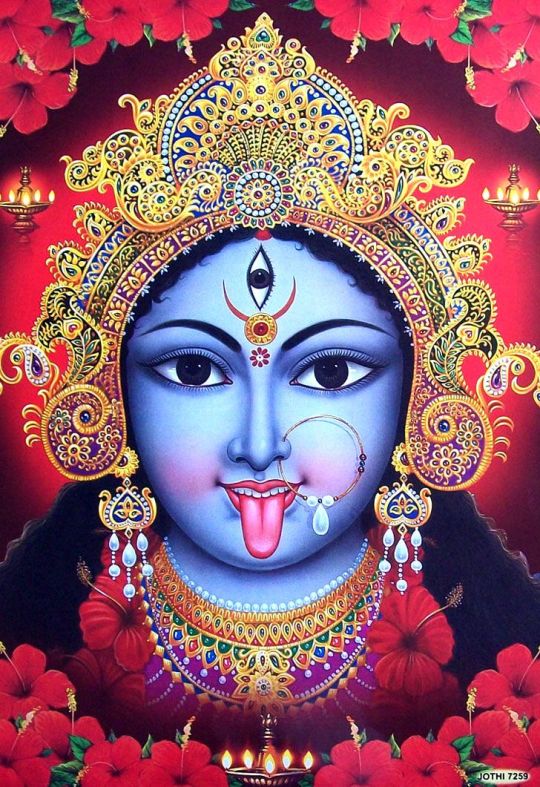
This card brings forth a massive wave of empowerment. As a cycle that no longer serves us is ending, a new order must be established. Kali is strong, powerful, and straight to the point. She does not fall back until divine consciousness tells her it's time; meaning there is no turning back until the order is met. This is a call for transformation and healing. I must be willing to let go of that which no longer serves me. To be courageous in the time of change and doubt in order to evolve into an entirely new state of being. Face uncertainty calmly, divine radical change is headstrong but also loving. Kali may rip my "lifeboat" out from under me but that is because she already knows that I'm an excellent swimmer. After so many years of toxic patterns lodging into my psyche, the only way to bring about change is not through subtlety, but through SACRED RADICAL REVOLUTION.
Love yourself and let go ~~~
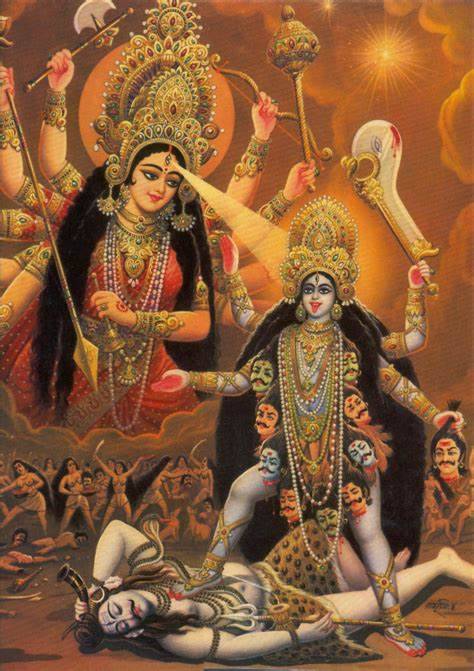
Partnered with the seer will and force of Kali, needs to be the self commitment to my own integrity. Listening to my body and my intuition when I am given the option between something that isn't in alignment with my highest truth. Anxiety, discomfort, that gut feeling you get when you agree to do something you know isn't corresponding with your inner integrity. Getting out of a relationship that is no longer serving regardless of the love that is there. Cutting back on the lifestlye that is killing me. Why does there seem to be such an internal pressure to do the things that I don't even want to do anymore, or to be what I'm not for another person to love me? Those patterns are so deep-rooted, so of course, the remedy needed is a dramatic shift, to knock us back into place. Kinda like a slap in the face. The more I use my voice and make choices that align with my truth, the easier it'll become for me to live that authentically. And the stronger, more secure of my Self I will be.
Light energy surrounds me, Kali is clearing the way, and now the rest is up to me. Spirit made it very clear during this morning's pull that I'm going to have to do A LOT of work. Waking up early one day out of the week to do yoga and journal won't be enough, but it is a damn good start. I need to slow down and take each day as it comes. I cannot become everything overnight.
Life is the ceremony ~~~
Less focus on finances and materialism and more on a healthy mind, body, and soul.
I am a goddess and a creatrix of my own reality.
The devil will always be there, tempting me, calling me home. I am not perfect, there is a side to me that enjoys the darkness. It has been my home for so long that I seek comfort there. But it is time to grow, to be the nurturer of my inner child. Give my Self the love and validation I've spent so long seeking from others. I am a seeker and student. I am so grateful for everything that has happened in my life to get me here. Every seed I plant and all the work I put forth will grow abundantly to fill me back up 10 fold.
So it will be <3
1 note
·
View note